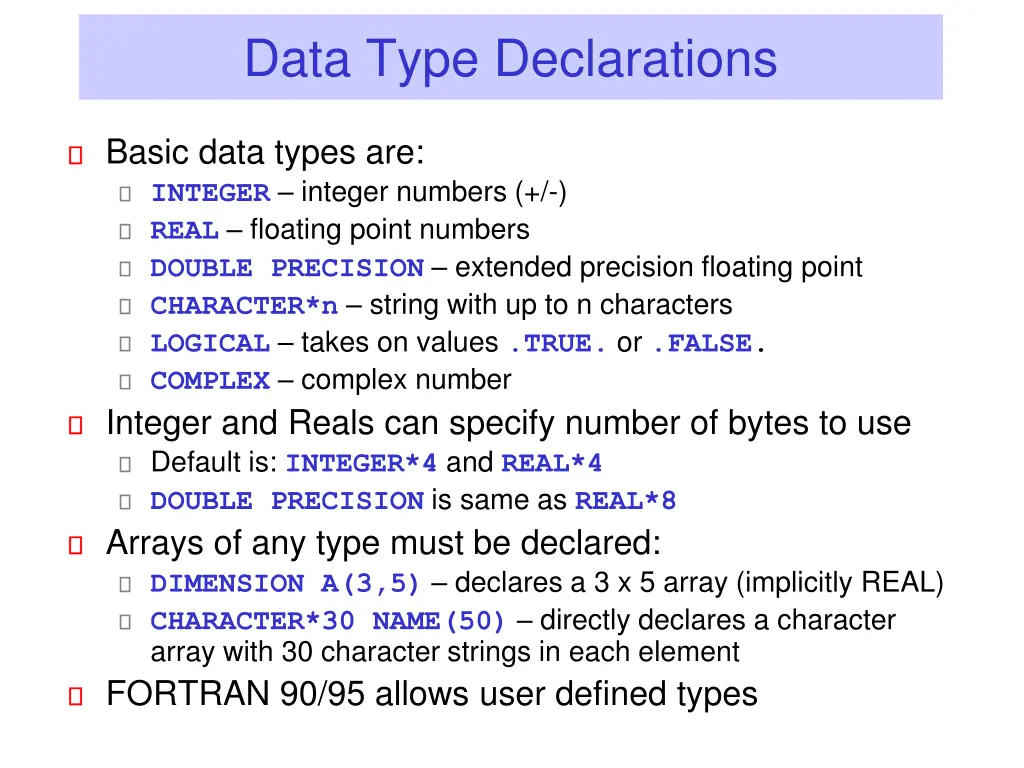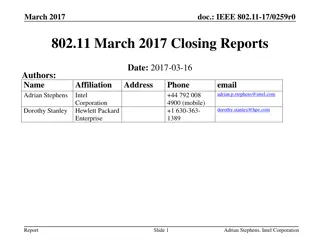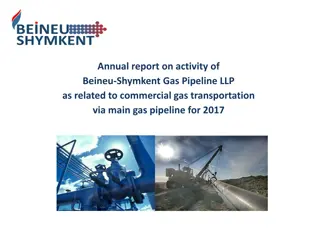
Understanding Fortran Data Type Declarations and Declarations in Programming
"Learn about basic data types in Fortran such as INTEGER, REAL, DOUBLE PRECISION, CHARACTER, LOGICAL, and COMPLEX numbers. Explore implicit vs. explicit declarations, defining constants, initializing variables, and assignment statements in Fortran programming."
Download Presentation

Please find below an Image/Link to download the presentation.
The content on the website is provided AS IS for your information and personal use only. It may not be sold, licensed, or shared on other websites without obtaining consent from the author. If you encounter any issues during the download, it is possible that the publisher has removed the file from their server.
You are allowed to download the files provided on this website for personal or commercial use, subject to the condition that they are used lawfully. All files are the property of their respective owners.
The content on the website is provided AS IS for your information and personal use only. It may not be sold, licensed, or shared on other websites without obtaining consent from the author.
E N D
Presentation Transcript
Data Type Declarations Basic data types are: INTEGER integer numbers (+/-) REAL floating point numbers DOUBLE PRECISION extended precision floating point CHARACTER*n string with up to n characters LOGICAL takes on values .TRUE. or .FALSE. COMPLEX complex number Integer and Reals can specify number of bytes to use Default is: INTEGER*4 and REAL*4 DOUBLE PRECISION is same as REAL*8 Arrays of any type must be declared: DIMENSION A(3,5) declares a 3 x 5 array (implicitly REAL) CHARACTER*30 NAME(50) directly declares a character array with 30 character strings in each element FORTRAN 90/95 allows user defined types
Implicit vs Explicit Declarations By default, an implicit type is assumed depending on the first letter of the variable name: A-H, O-Z define REAL variables I-N define INTEGER variable Can use the IMPLICIT statement: IMPLICIT REAL (A-Z) makes all variables REAL if not declared IMPLICIT CHARACTER*2 (W) makes variables starting with W be 2-character strings IMPLICIT DOUBLE PRECISION (D) makes variables starting with D be double precision Good habit: force explicit type declarations IMPLICIT NONE User must explicitly declare all variable types
Other Declarations Define constants to be used in program: PARAMETER (PI=3.1415927, NAME= BURDELL ) PARAMETER (PIO2=PI/2, FLAG=.TRUE.) these cannot be changed in assignments can use parameters to define other parameters Pass a function or subroutine name as an argument: INTRINSIC SIN the SIN function will be passed as an argument to a subprogram (subroutine or function) EXTERNAL MYFUNC the MYFUNC function defined in a FUNCTION subprogram will be passed as an argument to another subprogram
Initializing Variables The DATA statement can be used to initialize a variable: DIMENSION A(10,10) dimension a REAL array DATA A/100*1.0/ - initializes all values to 1.0 DATA A(1,1),A(10,1),A(5,5) /2*4.0,-3.0/ - initialize by element DATA (A(I,J),I=1,5,2),J=1,5) /15*2.0/ - initialize with implied-do list DATA FLAG /.TRUE./ - initialize a LOGICAL DATA NAME /30* * / - initialize a CHARACTER string Cannot initialize: dummy argument in a function or subroutine definition function, function result variables in COMMON blocks (more details later ) DATA statements can appear within the program code
FORTRAN Assignment Statements Assignment statement: <label> <variable> = <expression> <label> - statement label number (1 to 99999) <variable> - FORTRAN variable (max 6 characters, alphanumeric only for standard FTN-77) Expression: Numeric expressions: VAR = 3.5*COS(THETA) Character expressions: DAY(1:3)= TUE Relational expressions: FLAG= ANS .GT. 0 Logical expressions: FLAG = F1 .OR. F2
Numeric Expressions Very similar to other languages Arithmetic operators: Precedence: ** (high) - (low) Operator ** * / + - Function exponentiation multiplication division addition subtraction Casting: numeric expressions are up-cast to the highest data type in the expression according to the precedence: (low) logical integer real complex (high) and smaller byte size (low) to larger byte size (high) Example 3.42 + (A1+C0)/SIN(A) R**3
Character Expressions Only built-in operator is Concatenation defined by // - ILL // - // ADVISED Character arrays are most commonly encountered treated like any array (indexed using : notation) fixed length (usually padded with blanks) Example: CODE OUTPUT CHARACTER FAMILY*16 FAMILY = GEORGE P. BURDELL PRINT*,FAMILY(:6) PRINT*,FAMILY(8:9) PRINT*,FAMILY(11:) PRINT*,FAMILY(:6)//FAMILY(10:) GEORGE P. BURDELL GEORGE BURDELL
Hollerith Constants This is a relic of early FORTRAN that did not have the CHARACTER type.. Used to store ASCII characters in numeric variables using one byte per character Examples: 2HQW, 4H1234, 10HHELLOWORLD Binary, octal, hexidecimal and hollerith constants have no intrinsic data type and assume a numeric type depending on their use INTEGER*4 IWORD, KWORD INTEGER*2 CODE REAL*8 TEST CODE = 2HXZ IWORD = 4HABCD KWORD = O 4761 (octal) TEST = Z 3AF2 (hexidecimal) This can be VERY confusing; consult FORTRAN manual for target compiler! (avoid whenever possible)






















